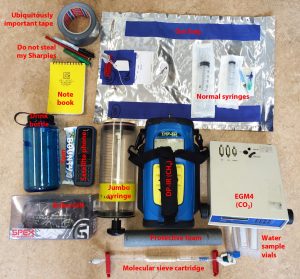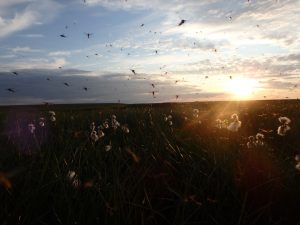
This bag belongs to
Joshua Dean, Postdoc, Vrije Universiteit Amsterdam
Field Work location
Far Eastern Siberian Arctic: Kytalyk Nature Reserve.
Duration of field work
2 weeks plus 3 days travel either side.
Items in the bag
- Detecto Pak-Infrared (DP-IR) gas analyser [borrowed from colleagues, protect at all costs]
- EGM4 CO2 gas analyser [borrowed from another department, protect at all costs]
- water sample vials [plus many tens of spares]
- molecular sieve cartridges [for capturing CO2 samples for radiocarbon analysis; Garnett et al., 2016a]
- foil gas bags [for capturing CH4 for radiocarbon analysis; Garnett et al., 2016b]
- small and large syringes, needles and stopcocks [for extracting dissolved CO2 and CH4 samples from water]
- jumbo (1L) syringe [for extracting jumbo water headspace samples for CO2 and CH4 radiocarbon sampling – also good for jumbo sized practical jokes]
- drink bottle [I normally bring a camelback] and snacks
- satellite phone [T‑mobile’s Siberian Arctic coverage is woeful]
- ski goggles as gift for Russian park ranger [so they will show me the protected mammoth graveyards in the nature reserve]
- waterproof notebook [to protect from the elements and clumsiness]
- duct tape [or duck tape depending on your tastes]
- sharpie/permanent markers [2 things you always need in the field, duct tape and permanent markers – always! It’s best if these are colour coded so you know if someone has stolen yours].

The essentials for aquatic greenhouse gas field sampling campaigns (photo credit: Joshua F. Dean, VU Amsterdam)
Not shown in photo
- exetainers® [for storing gas samples extracted from water]
- jumbo degassing vessel(s) [to match the jumbo syringe, see Garnett et al., 2016a and 2016b for more details]
- assorted spare parts [many, many, many spare parts – finding small bits of equipment that you dropped in the Arctic tundra is a nightmare, I lost a walkie-talkie in the tundra once]
- field team [for mental and physical assistance – absolutely vital
- Russian guide [because English is not to be found here]
- mosquito shirt and bug spray [the mosquitos love foreign blood, for an impression see below]
- spare food [in case you have an aversion to weird food, see previous post on the Blog].
Aim of the research
The aquatic pathway is known to be a potentially important export pathway of terrestrial carbon of all forms (Dinsmore et al., 2010), but while this is known to be a significant process in the Arctic (Vonk et al., 2015), we desperately lack in understanding of how this may be affected by the warming climate. We are taking measurements of freshwater carbon fluxes across a range of lakes, pools, rivers and streams in the Siberian Arctic tundra to estimate their contribution to the carbon budget of the landscape. We will compare this to measurements from the eddy covariance tower, both CO2 and CH4 fluxes, that we manage at the site (see previous post on the blog). We are also incorporating radiocarbon measurements within this to see whether climate change induced permafrost thaw is mobilising ancient carbon, which was previously locked up in the organic rich tundra soils, into the aquatic pathway.
One item I can’t live without
Beer… I can live without it, but when everything goes wrong in the field, you fall into a pool and/or stream, your camera gets wet, the batteries in all your equipment die, you lose repeated samples and the mosquitos have laid waste to every inch of your skin, it’s nice to relax with an ice cold beer in the evening. Luckily the permafrost in this area is shallow, so it’s easy to dig a temporary fridge.
References
Dinsmore, K.J., Billett, M.F., Skiba, U.M., Rees, R.M., Drewer, J., Helfter, C., 2010. Role of the aquatic pathway in the carbon and greenhouse gas budgets of a peatland catchment. Global Change Biology 16(10), 2750–2762.
Garnett, M.H., Gulliver, P., Billett, M.F., 2016a. A rapid method to collect methane from peatland streams for radiocarbon analysis. Ecohydrology 9, 113-121.
Garnett, M.H., Billett, M.F., Gulliver, P., Dean, J.F., 2016b. A new field approach for the collection of samples for aquatic 14CO2 analysis using headspace equilibration and molecular sieve traps: the super headspace method. Ecohydrology, doi:10.1002/eco.1754.
Vonk, J.E., Tank, S.E., Bowden, W.B., Laurion, I., Vincent, W.F., et al., 2015. Reviews and synthesis: Effects of permafrost thaw on Arctic aquatic ecosystems. Biogeosciences, 12, 7129-7167.
Dr. Joshua F. Dean from the VU University Amsterdam wrote this blogpost. He is a postdoctoral researcher who explores the carbon cycle in the Arctic and temperate peatlands to determine methane and carbon dioxide feedbacks under a warming climate. His work involves experimental approaches, modelling, and direct and indirect measurements of carbon dioxide and methane emissions from freshwater environments, with fieldwork campaigns throughout the Arctic and northern hemisphere peatlands.

